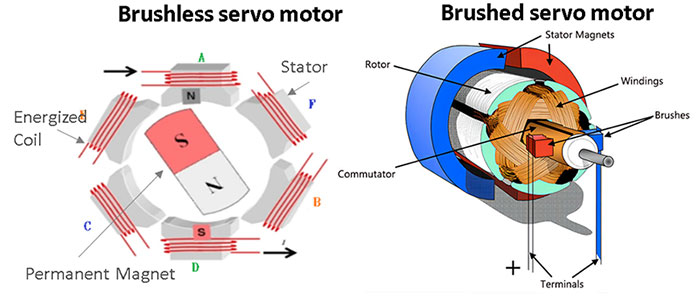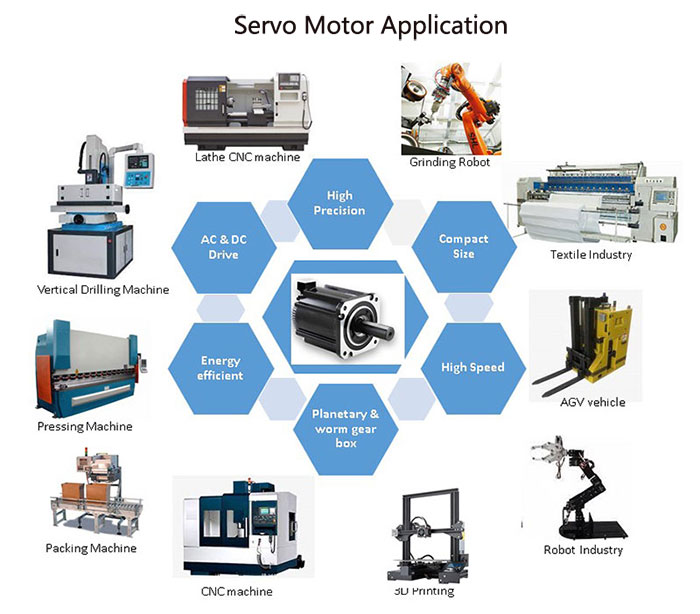
What is a servo motor?
Here is the servo motor definition. A servo motor is a type of electric device used in a closed-loop system to rotate machine parts with high efficiency and precision. Such servomotors are capable of controlling important mechanical functional parameters, such as position, speed, and torque using servo drive which are very crucial for any mechanical applications.

What are servo motors used for?
There is a wide application of servo motors in the industry because of their compact size, low noise, high precision and accuracy, high durability, energy efficiency, and high reliability. Most manufacturer needs servo motors for controlling position, rotating objects at precise angles, shifting and moving the objects at precise distances in CNC machines, forming machines, CNC lathes and bending machines for metal fabrication, robots, 3D printers, medical equipment, industrial automation equipment, AGV wheels, and other industrial applications.
Different types of servo motors
Generally speaking, there are some different types of servos based on applications.
- AC servo motor and DC servo motor – The primary difference between both AC servo motor and DC servo motor is in the inherent ability to control the speed. An AC servo motor in the control system features reliable stability, good speed, and high precision. In a DC servo motor, speed is directly proportional to the supply voltage with a constant load, while in an AC servo motor, speed depends on the frequency of applied voltage and several magnetic poles of the motor, not on the applied voltage.
- Brushed servo motor and brushless servo motor – There are some differences between brushed servo motor and brushless servo motor. Firstly, the brushed servo motor is less expensive and easy to operate. On the contrary, the brushless servo motor is more reliable has high efficiency, and is less noisy. Additionally, a DC servomotor is commutated with the brushes. While a DC brushless servo motor adopts an encoder, instead of brushes and commutator to achieve communications.

Parts of a servo motor
The Servo motor comprises dozens of parts which makes it highly effective and efficient. Every part contributes a vital role to the device's functionality. The main parts of an industrial servo motor are the stator, winding, shaft, rotor, encoder, servo motor driver, and additional brake and gearbox.
- Stator: it is a stationary component of electromagnetic circuits in servo motors and creates a rotating magnetic field to efficiently generate torque.
- Winding: A set of copper coils winding over the stator has different numbers of turns and different coil shapes. Current flows in the coils to produce a rotating magnetic field.
- Rotor: It's a permanent magnet that is attached to the motor's shaft and mounted by the two bearings.
- Shaft: The Servo motor shaft is made of highly rigid and durable material. It transmits the electric power of the motor into mechanical rotating power to drive the equipment connected to the shaft.
- Encoder: The servomotor encoder measures the position of the shaft, rotation angle, speed, travel distance, and torque and transmits the positional feedback to the controller by determining the number of rotations being completed by the shaft. Peaco supports customized servo motors with absolute encoder and incremental encoder
- Servo motor driver: The servo motor drive also called the servo motor controller, is an electronic amplifier used to power electric servomechanism by monitoring the feedback signal from servomechanism in a closed loop and adjusting the deviation expected behavior.
- Brake Servo: It’s the additional part of the servo motor that is attached to the back of the servo motor. The Servo motor brake plays an important role in holding the load in place when the servo motor drive fails or power is lost.
- Gearbox: A set of gears are assembled over each other inside the gearbox casing to reduce the speed of the motor and increase the torque where high torque is required. The gearbox is mounted to the shaft of the servo motor. Each type of gearbox has its advantages and disadvantages, which gearbox is suitable for you depends on your particular application and feasibility to install. Some common gears are spur gearbox, helical gearbox, worm gearbox, and planetary gearbox. Peaco Support uses a highly advanced planetary gearbox and worm gearbox with AC servo motor and DC servo motor.
Application of servo motor
Servo motors are devices designed to convert the voltage signal into torque and speed to drive the controlled object and can control the speed with a highly precise position.
Servo motors are widely utilized in automobiles, robots, 3D printings, medical instruments, AGV wheels, machinery industrial equipment, CNC machines, lathes, milling, advanced robot grinding machines, tool making industry, casting machining, grinding operations, packing & fabrication machines, electric two-wheeler, commercial and passenger vehicles, and other industrial equipment.
 style="width: 700px;">
style="width: 700px;">
Buy servo motors in Peaco Support. As a reliable servo motor manufacturer and supplier, Peaco Support provides a complete solution for both DC servo motors and AC servo motors. Such precision servo motors can be matched with optional servo motor drives, gearboxes, and brakes with high quality and at a highly competitive price.
